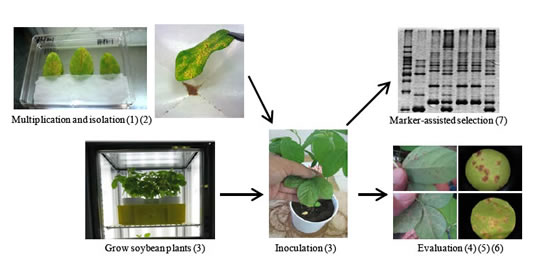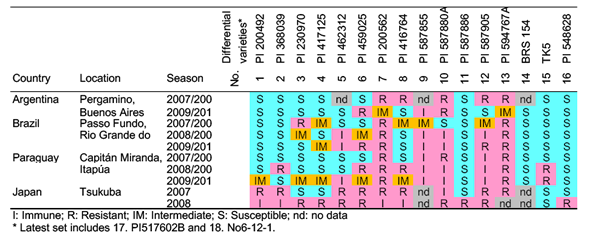Laboratory manual for studies on soybean rust resistance
Description
Soybean [Glycine max (L.) Merrill] is an economically important legume crop and is exported more than 80 million ton to the world market mainly from North and South American countries. Soybean disease, Asian soybean rust (ASR) caused by Phakopsora pachyrhizi Sydow & P. Sydow, is one of the biggest threats to stable soybean production in South America and in the other tropical and sub-tropical regions. Thus, various studies have been done related to pathogenic variations of ASR and to development of ASR resistant cultivars in each country. Since ASR pathogens widely spread over the border, each country has to cope with this disease based on the information obtained by the common methodology of resistance evaluation. However, it was difficult to compare the pathogenicity of ASR pathogens and the degree of ASR resistance in soybean genotypes among countries because evaluation method related to ASR resistance was not standardized among the countries.
Therefore, at first, we standardized the experimental protocols: 1) multiplication of ASR urediniospores, 2) single-lesion isolation, 3) inoculation of soybean with spore suspension, 4) evaluation of ASR pathogenicity, 5) evaluation of ASR resistance in soybean genotypes, and 6) evaluation of ASR tolerance of soybean genotypes (Figure 1, Table 1) in order to obtain reproducible results of these experiments. South American ASR pathogens and the differential varieties are utilized for this work (Table 2). Then, we optimized experimental protocols related to SSR marker analysis for the marker-assisted selection (MAS) in order that domestic institutions in South America can carry out their soybean breeding programs for ASR resistance. Finally we compiled these standardized experimental protocols into a single manual: ‘Laboratory manual for studies on soybean rust resistance’ can be accessed from JIRCAS website: http://www.jircas.affrc.go.jp/english/manual/soybean_rust/JIRCAS_manual_soybean_rust.pdf.
The data for the pathogenicity of ASR pathogens and for the degree of ASR resistance in soybean genotypes obtained by following this manual can be compared with the data previously obtained (Akamatsu et al., 2013). Therefore, this manual can promote the researches related to the pathogenic variations of ASR pathogens and the marker-assisted soybean breeding for ASR resistant cultivars.
Figure, table
-
Fig. 1. Evaluation process for Asian soybean rust (ASR) resistance. The numbers in the figure correspond to that of Table 1.
-
Table 1. Contents of the manual for Asian soybean rust (ASR) resistance.
-
Table 2. Example of pathogenic data for Asian soybean rust (ASR) pathogens based on the resistance reactions of the differential varieties.
- Affiliation
-
Japan International Research Center for Agricultural Sciences Biological Resources and Post-harvest Division
- Classification
-
Administration B
- Research project
- Program name
- Term of research
-
FY 2013 (FY 2011-FY 2015)
- Responsible researcher
-
Yamanaka Naoki ( Biological Resources and Post-harvest Division )
MIERUKA ID: 001770Akamatsu Hajime ( Biological Resources and Post-harvest Division )
Yamaoka Yuuichi ( University of Tsukuba )
KAKEN Researcher No.: 00220236 - ほか
- Publication, etc.
-
“Laboratory manual for studies on soybean rust resistance” http://www.jircas.affrc.go.jp/english/manual/soybean_rust/JIRCAS_manual…
https://doi.org/10.1590/S1984-70332013000100009Yamanaka, N. et al. (2013) Crop Breed Appl Biotechnol, 13: 75-82
https://doi.org/10.1007/s10327-012-0421-7Akamatsu, H. et al. (2013) J Gen Plant Pathol, 79: 28-40
- Japanese PDF
-
2013_B01_A3_ja.pdf308.63 KB
2013_B01_A4_ja.pdf512.53 KB
- English PDF
-
2013_B01_A3_en.pdf184.15 KB
2013_B01_A4_en.pdf233.42 KB
- Poster PDF
-
2013_B01_poster.pdf363.3 KB



